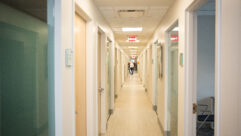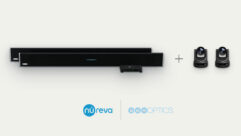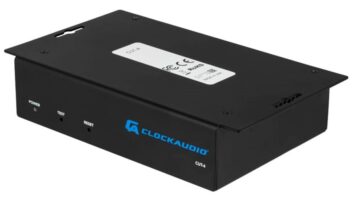Location, Location, Location
In the real estate and pro AV industries, location often makes the difference.
Researchers at Graz University of Technology in Austria are using Ubisense’s RTLS system for “augmented reality” (AR): a real-world environment enhanced by computer-generated graphics, sounds, and smells. The RTLS system uses ultrawideband (UWB) wireless to track AR users in order to update their virtual surroundings as they move about.”>
Researchers at Graz University of Technology in Austria are using Ubisense’s RTLS system for “augmented reality” (AR): a real-world environment enhanced by computer-generated graphics, sounds, and smells. The RTLS system uses ultrawideband (UWB) wireless to track AR users in order to update their virtual surroundings as they move about.
WITH DATA RATES of 100 Mb/s or more, ultrawideband (UWB) wireless sounds like a potential fit for bandwidth-intensive AV applications such as high-definition (HD) video, and it is. But UWB also can locate people and objects, an ability that sets the stage for additional pro AV applications.
One example is taking shape at Graz University of Technology in Austria. Researchers in the school’s Institute of Computer Graphics and Vision are using UWB for “augmented reality” (AR): a real-world environment enhanced by computer-generated graphics, sounds, and smells. Graz University is using UWB to track AR users in order to update their virtual surroundings as they move about. “Knowing the accurate position and orientation of a mobile user is the key to doing the overlay of virtual information over the real-world video stream properly,” says DI Gerhard Schall, a Graz University researcher.
Big Pipe
UWB uses brief pulses of energy to transmit data at speeds of 100 Mb/s or more. That Morse code-like approach also makes the UWB signal more resistant to physical obstructions, such as walls. UWB’s name comes from the way that it spreads a signal over a far wider swath of spectrum — hundreds of Megahertz — than other wireless technologies do.
UWB has a range of about 30 feet, although it can be tweaked to cover larger areas. (The actual distance depends on the amount of power that regulators allow in a particular country.) It can also be souped up to support throughput of up to 2 Gb/s.
AV, computer, and telecom vendors have been working on UWB for several years. At the 2003 Consumer Electronics Show (CES), for example, chipset vendor XtremeSpectrum used UWB to send multiple HDTV streams to two separate displays. And at press time, Belkin was set to launch a $200 UWB hub for connecting PCs and peripherals such as cameras and printers.
Tag, You’re It
UWB also can be used to locate people and objects via techniques such as triangulation, where multiple sensors around a room essentially compare notes about the wireless signals to pinpoint the location of a UWB tag. “UWB is fairly accurate, with resolution on the order of 6 inches,” says Henning Schulzrinne, a Columbia University professor and chair of its Department of Computer Science. “It’s hard to find other technologies that can approach that level of accuracy.”
But UWB isn’t unique in its ability to communicate data and support location tracking at the same time. Another example is radio frequency identification (RFID), which is a short-range wireless technology used in retail to track merchandise from the factory to the store shelf.
Some AV vendors are leveraging the growing installed base of RFID-tagged products in the retail world. One example is BTV+, based in Mississauga, Ontario, Canada. The company has developed an interactive digital signage system — branded as ADvantage RFID — that uses an embedded RFID scanner to identify nearby merchandise. When a shopper picks up a tagged item, the ADvantage RFID system triggers the display to present ads or other information that aims to improve the chances of a sale.
Depending on the application’s requirements — such as budget and bandwidth — RFID could be used in lieu of UWB. “We do use other room-level RFID systems in our experiments, but they only identify location down to a room, not within the few inches that are feasible with UWB,” Schulzrinne says. “Most RFID systems have extremely short range of a few inches, so they aren’t terribly useful for locating individuals.”
Follow Me
Schulzrinne and his colleagues are using a UWB solution from Cambridge, England-based Ubisense to develop location-aware applications. One example is a conferencing system that adjusts the videocamera’s position to follow a participant as she moves around a room. The participant wears a small UWB tag that’s tracked by sensors in the room. The system also can track multiple tags at the same time.
Another benefit of UWB is that it doesn’t require a clear line of sight between the tag and sensor. That robustness provides more flexibility for the integrator designing the system and for the people using it. “It’s possible to track an object or person through or around smaller or thinner physical obstructions,” says Graz University’s Schall. “If, for example, the UWB tag is occluded by the user’s body, the tag still can be tracked. For the UWB system, there’s no strict need for direct line of sight, which isn’t the case when using infrared tracking systems.”
However, one wild card is building materials. Some types of materials can cause the UWB signals to ping-pong. “UWB systems are limited by the reflective properties of many modern building materials,” says Schall, who’s using the Ubisense technology for the AR research. “Metal surfaces in the environment can decrease performance because signals can be reflected at those surfaces, which leads to multipath signals. Consequently, careful configuration, calibration, and ongoing maintenance by experienced technicians are often necessary.”
One way to mitigate gremlins such as multipath is by deploying more UWB sensors around the room. “The more Ubisensors receive signals from a Ubitag, the better the accuracy of the position estimate of the Ubitag,” Schall says.
Granularity is Good
Ubisense is already targeting applications such as interactive museum exhibits with its UWB-based Real-Time Location System (RTLS) product. “We can tell if a person is in front of an exhibit or, if it’s a large exhibit, which area of the exhibit they’re in,” says Jay Cadman, the company’s vice president of global marketing. “This enables applications that have a greater granularity of understanding about a person’s locations and movements throughout a space, rather than being able to tell if a person is simply inside a particular room.”
The more granular a location technology is, the wider the range of AV applications that it can support. “By knowing exact locations, the quality of the experience and the educational value is dramatically increased,” Cadman says. “For example, if I know a person spent more time in an exhibit viewing a particular product, I can tailor additional information that person receives to be related to that particular product or line of technology. This greatly enhances the customer experience.”
Granularity also can span three dimensions, such as whether a person is on a particular level of a large room. That’s the case with the Ubisense technology that Graz University is using for its AR research.
“The use of both time-difference-of-arrival (TDOA) and angle-of-arrival (AOA) techniques for position calculation in the wall-mounted sensors makes it possible to locate a tag within 30 cm in three dimensions,” Schall says.
Making the Business Case
UWB is relatively new in terms of commercial availability, so it currently has a price premium compared to technologies such as RFID that have been shipping in volumes for years. “UWB is much more expensive right now — systems cost well over $10,000 — so it’s harder to justify outside of a research context,” Schulzrinne says.
But Ubisense counters that its UWB solution is competitive today. “Hardware costs related to UWB in comparison to other active technologies such as 802.11 are very similar,” Cadman says.
Either way, the business case for using UWB depends largely on whether the granular location information is necessary for the application to deliver a good user experience. “If they need to know someone is simply in a room, then less precise technologies will suffice,” Cadman says. “If they need to know exactly where someone is located in a room, then UWB is the answer.”
UWB could be a good fit for AV applications that require both precise location information and a high-bandwidth pipe — an ability that Ubisense is working on.
“In the future, we anticipate having a tag that has integrated communications as well as location,” Cadman says. “This would allow us to provide to our partners and OEMs not just precise location information, but also a means of high-bandwidth data communications.”
MORE ON WWW.PROAVMAGAZINE.COM
For more information about UWB and other wireless technologies in AV, check out our web-exclusive sidebar to this article, which includes links to research, white papers, and related past articles.
Tim Kridel is a freelance writer and analyst who covers telecom and technology. He’s based in Kansas City and can be reached at [email protected].










